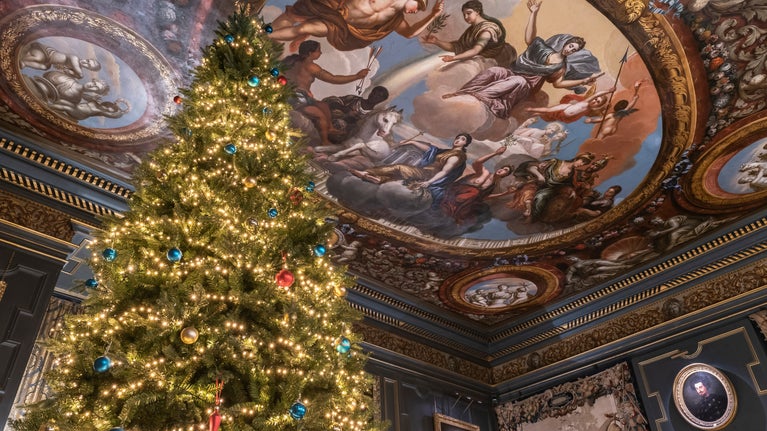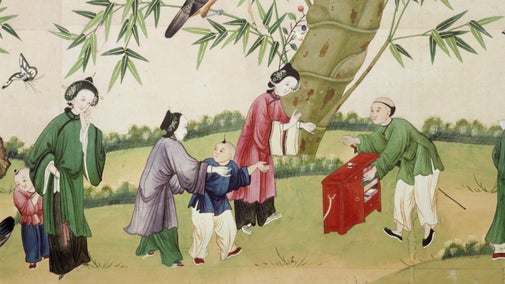
Immerse yourself in history
Meet people from the centuries gone by, learn about the unique artworks in our care and understand more about historic traditions.

With millions of cups of tea drunk in Britain every day, it’s no secret that we’re a nation of tea lovers. From the Duchess’s teapot at Ham House to the ornate Tea Room at Polesden Lacey, the places we care for are full of stories that explain how this simple brew has become a British institution.
When tea first arrived from China in the mid-17th century, it was so expensive that only the royal family and wealthy aristocrats could afford to buy it. As a new luxury from East Asia, the ceremony of brewing and serving was copied from the Chinese. The lady of the house took charge of the kettle and teapot and served the tea in tiny porcelain bowls.
In her Private Closet at Ham House, Surrey, the Duchess of Lauderdale (1626–1698) kept a Chinese white porcelain tea pot with a distinctive crackled glaze. Made at the Zhangzhou kilns in Fujian province, this exceedingly rare teapot was later fitted in England with silver-gilt mounts. The pink tinge now visible on the teapot was probably caused by years of hot tea seeping through the glaze.

In the 18th century, lockable tea caddies made an appearance in the homes of the wealthy. Not only were they a means of safely storing expensive tea, but they were ostentatious displays of wealth. They were often made of expensive wood and elaborately decorated, like this mahogany example from A La Ronde in Devon.
Ornate teapoys were also made for storing tea. They were often richly carved or decorated with elaborate inlay. Like tea caddies, they were usually divided into compartments for storing different types of tea.
During the 18th century, more teas of different grades were imported. The middle and lower classes began to drink tea in pleasure gardens, spa towns and at home.
Employers started to provide teapots and tea so that staff could stop and enjoy a ‘tea break’. At Saltram, Devon, records show that servants’ pay in the 18th century included an allowance of tea and at Quarry Bank, Cheshire, tea was provided for the mill workers.
In the 19th century, the arrival of cheaper quantities of Assam, Darjeeling and Ceylon black teas meant that everyone could afford to drink more.
Public tea-rooms started to open around the country, serving pots of tea at very low prices. In the countryside, industrious owners of cottage gardens served home-baked cakes and tea to weary cyclists and tourists.
Dame Margaret ‘Maggie’ Greville (1863-1942) was a famed society hostess. She refurbished Polesden Lacey to her own luxurious tastes and included an elegant Tea Room. Her highly fashionable afternoon teas were attended by the aristocracy, statesmen and royalty.

As the nation's thirst for tea developed, tea dealers grew rich from their profits. Julius Drewe, founder of the Home and Colonial grocer chain in 1883, made so much money selling tea that he was able to retire at the age of 33 and build the impressive Castle Drogo in Devon.
Legend has it that the first cup of National Trust tea was brewed at Hidcote, Gloucestershire, when the gardener and his wife served up cups of tea and buns to visitors through their cottage windows.
It's commonly believed that afternoon tea was first introduced by Anna, Duchess of Bedford in 1840. It wasn’t long before the upper and many of the middle classes of Britain were also enjoying tea with dainty sandwiches and cakes served in the drawing room, or sometimes the garden, at 4 or 5 o'clock in the afternoon. This light meal filled the gap between lunch and a fashionably late dinner or supper at around 8 o'clock in the evening.
Afternoon tea as daily social ritual reached its zenith during the Edwardian era. Ladies would dress for tea in elegant tea gowns and picture hats and men would wear smart suits.
Afternoon tea should not be confused with high tea. Enjoyed by working-class families after a long day at work, high tea was a hearty meal of dishes such as pies, cheese on toast and meats, all served with a cup or mug of tea.
During the 19th and 20th centuries it became popular to mark national or personal celebrations by holding festive teas.
Traditionally the completion of harvest would be marked by a celebratory festival and meal. Harvest Tea (1983) by Mary Martin at Cotehele depicts a more informal picnic tea being celebrated in a Cornish field, a reminder that celebration teas are still very much part of our modern culture.
See Harvest Tea.

Meet people from the centuries gone by, learn about the unique artworks in our care and understand more about historic traditions.
From stunning décor in the Gold Saloon to state-of-the-art conveniences, explore the ground floor of Margaret Greville's house at Polesden Lacey, a luxurious house fit for royalty.

We look after the largest collection of historic Chinese wallpapers on permanent public display in the world. Learn more about the evolution of paper wallcoverings and the different styles through the centuries.

Discover highlights from our collection of around 75,000 ceramic objects, from an early Ming dynasty dish to an ancient Greek hydria.

The East India Company was probably the most powerful corporation in history. At its height, it dominated global trade between Europe, South Asia and the Far East, fought numerous wars using its own army and navy, and conquered and colonised modern day India, Pakistan, Bangladesh and Burma.
